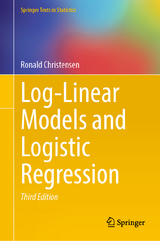
Log-Linear Models and Logistic Regression
Seiten
2013
|
2nd ed. 1997. Softcover reprint of the original 2nd ed. 1997
Springer-Verlag New York Inc.
978-1-4757-7113-8 (ISBN)
Springer-Verlag New York Inc.
978-1-4757-7113-8 (ISBN)
- Titel erscheint in neuer Auflage
- Artikel merken
Zu diesem Artikel existiert eine Nachauflage
As the new title indicates, this second edition of Log-Linear Models has been modi?ed to place greater emphasis on logistic regression. The matrix approach to log-linear models and logistic regression is presented in Chapters 10-12, with Chapters 10 and 11 at the applied Ph.D.
As the new title indicates, this second edition of Log-Linear Models has been modi?ed to place greater emphasis on logistic regression. In addition to new material, the book has been radically rearranged. The fundamental material is contained in Chapters 1-4. Intermediate topics are presented in Chapters 5 through 8. Generalized linear models are presented in Ch- ter 9. The matrix approach to log-linear models and logistic regression is presented in Chapters 10-12, with Chapters 10 and 11 at the applied Ph.D. level and Chapter 12 doing theory at the Ph.D. level. The largest single addition to the book is Chapter 13 on Bayesian bi- mial regression. This chapter includes not only logistic regression but also probit and complementary log-log regression. With the simplicity of the Bayesian approach and the ability to do (almost) exact small sample s- tistical inference, I personally ?nd it hard to justify doing traditional large sample inferences. (Another possibility is to do exact conditional inference, but that is another story.) Naturally,Ihavecleaneduptheminor?awsinthetextthatIhavefound. All examples, theorems, proofs, lemmas, etc. are numbered consecutively within each section with no distinctions between them, thus Example 2.3.1 willcomebeforeProposition2.3.2.Exercisesthatdonotappearinasection at the end have a separate numbering scheme. Within the section in which it appears, an equation is numbered with a single value, e.g., equation (1).
As the new title indicates, this second edition of Log-Linear Models has been modi?ed to place greater emphasis on logistic regression. In addition to new material, the book has been radically rearranged. The fundamental material is contained in Chapters 1-4. Intermediate topics are presented in Chapters 5 through 8. Generalized linear models are presented in Ch- ter 9. The matrix approach to log-linear models and logistic regression is presented in Chapters 10-12, with Chapters 10 and 11 at the applied Ph.D. level and Chapter 12 doing theory at the Ph.D. level. The largest single addition to the book is Chapter 13 on Bayesian bi- mial regression. This chapter includes not only logistic regression but also probit and complementary log-log regression. With the simplicity of the Bayesian approach and the ability to do (almost) exact small sample s- tistical inference, I personally ?nd it hard to justify doing traditional large sample inferences. (Another possibility is to do exact conditional inference, but that is another story.) Naturally,Ihavecleaneduptheminor?awsinthetextthatIhavefound. All examples, theorems, proofs, lemmas, etc. are numbered consecutively within each section with no distinctions between them, thus Example 2.3.1 willcomebeforeProposition2.3.2.Exercisesthatdonotappearinasection at the end have a separate numbering scheme. Within the section in which it appears, an equation is numbered with a single value, e.g., equation (1).
Two-Dimensional Tables and Simple Logistic Regression.- Three-Dimensional Tables.- Logistic Regression, Logit Models, and Logistic Discrimination.- Independence Relationships and Graphical Models.- Model Selection Methods and Model Evaluation.- Models for Factors with Quantitative Levels.- Fixed and Random Zeros.- Generalized Linear Models.- The Matrix Approach to Log-Linear Models.- The Matrix Approach to Logit Models.- Maximum Likelihood Theory for Log-Linear Models.- Bayesian Binomial Regression.
| Reihe/Serie | Springer Texts in Statistics |
|---|---|
| Zusatzinfo | XVI, 484 p. |
| Verlagsort | New York, NY |
| Sprache | englisch |
| Maße | 155 x 235 mm |
| Themenwelt | Mathematik / Informatik ► Mathematik ► Algebra |
| Mathematik / Informatik ► Mathematik ► Angewandte Mathematik | |
| Mathematik / Informatik ► Mathematik ► Wahrscheinlichkeit / Kombinatorik | |
| ISBN-10 | 1-4757-7113-4 / 1475771134 |
| ISBN-13 | 978-1-4757-7113-8 / 9781475771138 |
| Zustand | Neuware |
| Informationen gemäß Produktsicherheitsverordnung (GPSR) | |
| Haben Sie eine Frage zum Produkt? |
Mehr entdecken
aus dem Bereich
aus dem Bereich
Mathematik von Studierenden für Studierende erklärt und kommentiert
Buch | Softcover (2024)
Springer Spektrum (Verlag)
CHF 48,95
Begriffe, Sätze und zahlreiche Beispiele in kurzen Lerneinheiten
Buch | Softcover (2022)
Springer Spektrum (Verlag)
CHF 76,95
Buch | Softcover (2022)
Springer Spektrum (Verlag)
CHF 55,95



